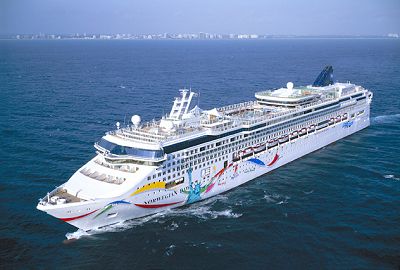
Amazing that only four were injured.
"after it hit vicious seas in an overnight storm off Florida - then was creamed by the rogue wave after dawn."
Bermuda Triangle?

Last year, Norwich virus.
This year, Mel Blank gets creamed by a rogue wave.
I belee...I belee...I belee...That's All Folks!
The USS Pickaway LPA 222 was hit with a rogue wave like this back in the late 60's in the south China Sea--Darn I am an old man!
Partial refund???, Future trip?? not the near furure I would bet. The ship's open bar? Priceless,and very crowded.
my initial thoughts were to the effect that perhaps that infamous Michael Moore was on board and he farted - therefore the huge wave was generated as a result.

Quite a proud ship to have survived a 70-foot wave. I bet its architect must feel ten feet tall today!

Didn't this happen to the QE2 about a year ago, and didn't they see it coming? Caught it on RADAR as I recall. Wonder why this one sneaked up on them?
A partial refund for a freak sea--wow, what an age we live in. Someone must ALWAYS pay.

Was the captain planning on using the Beeline? Hey reporter, Orlando is in the MIDDLE of the state.
The passengers should sue the cruse snip, they should of known there was water in the ocean.
1943, North Atlantic. Cruise liner Queen Elizabeth ploughs into a trough and is hit by two massive waves in succession. The impacts shatter the bridge windows 28 meters above the waterline.
1944, Indian Ocean. British Royal Navy cruiser Birmingham plunges into a deep hole then takes a huge wave over her bows. The commander reports wading through knee-high water on a deck more than 18 meters above sea level.
1966, North Atlantic. Italian steamship Michelangelo is hit by a 21-metre wave en route to New York. The water smashes through the bridge and into the first class compartments, killing two passengers and a crew member.
1995, North Sea. Statoil floating rig Veslefrikk B is severely damaged by a rogue wave. One crew member describes a "wall of water" visible for several minutes before it strikes.
1995, North Atlantic. The QE2 encounters a hurricane on a crossing to New York. She takes a 29-metre wave over her bow. "It looked as if we were going into the White Cliffs of Dover," says Captain Ronald Warwick.
1998, North Atlantic. Schiehallion, a BP Amoco floating production platform, is struck by a wave which smashes the fo'c'sle 18 meters above the waterline.
2000, North Atlantic. British cruise liner Oriana is hit by a 21-metre wave while answering a mayday call from a yacht 600 miles west of Cork, Ireland.
From New Scientist magazine, vol 170 issue 2297, 30/06/2001
Most of my Army career was at sea – and a rogue wave was about the only hazard I never experienced. It was also the only hazard I did not wish to experience.
I would think that the navigator and the captain were asleep on this one. There isn't any reason to put to sea in this type of weather in a cruise ship. Once at sea a cruise ship should do all that is possible to navigate around this type of weather.
This thing doesn't have the luxury of water tight hatches and doors nor does it have a military mission.
I rode out a few storms in a U.S.Navy tin can that was less than five hundred feet long. Sailors in storms are one thing whereas civilians are another.
Surely this vessel had at the least the Weather Channel available.
I Googled it. http://www.roblightbody.com/liners/qe-2/1995_freak_wave.htm
Nope, no talk of RADAR.
In one prominent rogue-wave encounter, Capt. Ronald Warwick, who followed in his father's footsteps to command the British ocean liner Queen Elizabeth II, was on the bridge at 4 a.m. on Sept. 11, 1995. Two hundred miles off Newfoundland, headed for New York, Warwick had been trying, without success, to dodge Hurricane Luis.
Minutes before, monstrous seas smashed windows in the Grand Salon, 72 feet off the water. Warwick had given the order confining passengers to quarters.
Suddenly, a huge wave loomed off the bow, huge even for a ship the size of the QE2, at nearly 1,000 feet long, more than 100 feet wide, carrying nearly 3,000 people.
Hundreds of miles from shore, the face of the wave was steep, like a breaking wall of water. Warwick later described that "it looked as though the ship was headed for the white cliffs of Dover."
Officers on the bridge estimated the wave at 92 feet, because they were eyeball to eyeball with the crest.
"(I)t broke with tremendous force over the bow. An incredible shudder went through the ship, followed a few minutes later by two smaller shudders," Warwick recalled in a 1996 article in Marine Observer.
The ship's bow dropped into a "hole" of a trough behind the first wave and was hit by a second wave of between 91 and 96 feet high that cleaned a mast right off the foredeck.
Warwick, his passengers and crew were lucky. No one was injured. It was a far different fate for the German container ship Munchen, which sank in the middle of the Atlantic in 1978 with no warning, no May Day.

AV
ping!